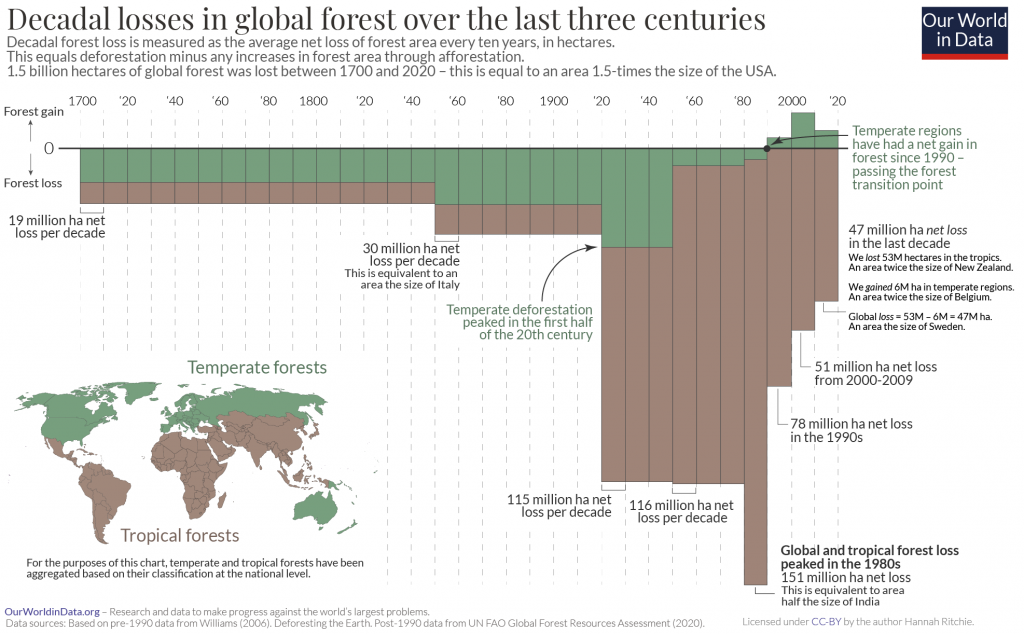How Sustainable Is Basswood? Here Are the Facts
Impactful Ninja is reader-supported. When you buy through links on our site, we may earn an affiliate commission.
Learn more
Learn more
.
Hey fellow impactful ninja ? You may have noticed that Impactful Ninja is all about providing helpful information to make a positive impact on the world and society. And that we love to link back to where we found all the information for each of our posts. Most of these links are informational-based for you to check out their primary sources with one click. But some of these links are so-called "affiliate links" to products that we recommend. First and foremost, because we believe that they add value to you. For example, when we wrote a post about the environmental impact of long showers, we came across an EPA recommendation to use WaterSense showerheads. So we linked to where you can find them. Or, for many of our posts, we also link to our favorite books on that topic so that you can get a much more holistic overview than one single blog post could provide. And when there is an affiliate program for these products, we sign up for it. For example, as Amazon Associates, we earn from qualifying purchases. First, and most importantly, we still only recommend products that we believe add value for you. When you buy something through one of our affiliate links, we may earn a small commission - but at no additional costs to you. And when you buy something through a link that is not an affiliate link, we won’t receive any commission but we’ll still be happy to have helped you. When we find products that we believe add value to you and the seller has an affiliate program, we sign up for it. When you buy something through one of our affiliate links, we may earn a small commission (at no extra costs to you). And at this point in time, all money is reinvested in sharing the most helpful content with you. This includes all operating costs for running this site and the content creation itself. You may have noticed by the way Impactful Ninja is operated that money is not the driving factor behind it. It is a passion project of mine and I love to share helpful information with you to make a positive impact on the world and society. However, it's a project in that I invest a lot of time and also quite some money. Eventually, my dream is to one day turn this passion project into my full-time job and provide even more helpful information. But that's still a long time to go. Stay impactful,Affiliate Disclosure
Why do we add these product links?
What do these affiliate links mean for you?
What do these affiliate links mean for us?
What does this mean for me personally?
![]()
Basswood is a soft hardwood species, easy to be machined and shaped into thin sections. Some telltale signs of basswood’s sustainability are fast growth rate and vegetative reproduction. However, as the basswood trees support a lot of mammals, birds, and insects, cutting down the trees hurts wildlife. So we had to ask: How sustainable is it to buy products made out of basswood?
Basswood is sustainable thanks to the trees’ carbon sequestration potential. This timber is easy to dry and work with, resulting in a relatively low manufacturing carbon emission. Also, fuel consumption for transporting basswood is comparatively efficient thanks to its lightweight.
In this article, we’ll walk you through the life-cycle of basswood used for musical instruments, carvings, and other woodworking projects. Then, we evaluate its sustainability, potential, and shortfalls. And in the end, we’ll show you tips for buying sustainable basswood.
Here’s How Sustainable Basswood Is
Basswood is a sustainable material because of the basswood trees’ carbon sequestration potential and the carbon offset value at the end of any products made with basswood.
“Sustainable: The ability to be maintained at a certain rate or level | Avoidance of the depletion of natural resources in order to maintain an ecological balance”
Oxford Dictionary
To understand the sustainability of basswood, we assess the life-cycle of basswood carvings and musical instruments. This life-cycle assessment (LCA) is a method to evaluate the environmental impacts of each stage in a product’s life-cycle, from the making to the recycling. Over the years, companies have strategically used LCA to research and create more sustainable products.
In this article, we’ll use the cradle-to-grave perspective of the LCA, examining the five stages of the life-cycle of furniture and flooring made with basswood. However, you will also find some cradle-to-gate data where relevant.
| The life-cycle stages of basswood | Each stage’s sustainability |
| Growing of basswood | Growing basswood trees is sustainable thanks to carbon sequestration during the tree’s lifespan. Also, these species can regenerate easily after timber cutting and provide many other benefits. |
| Manufacturing of basswood | Turning basswood into musical instruments or carvings has a relatively low carbon footprint. Kiln-drying – the most carbon-intensive step in manufacturing – results in 38.5 kg CO2-eq for 1m3 of Basswood lumber, 4/4 (1 inch) thick. Wood waste can be recycled fully as by-products or biomass pellets to offset the carbon emissions during harvesting and processing. |
| Transporting of basswood | Transporting is a relatively carbon-intensive stage in the life-cycle of basswood due to the emissions associated with operating the hauling vehicles that take timber to sawmills and factories, then furniture to stores. As basswood trees are locally grown in the US, a piece of basswood instrument would have a lower carbon footprint than that made from imported woods. |
| Usage of basswood | Using basswood products can be sustainable thanks to the carbon capture during the products’ long life. |
| End-of-life of basswood | The end-of-life stage for basswood products is sustainable when the wood is reused or burned as bioenergy. |
Overall, we can say that basswood is sustainable. However, the actual environmental impact of a particular product like a guitar depends on more specific factors, especially the distance and mode of transportation. Let’s dive deeper into each life-cycle stage and find out how you can buy basswood more sustainably.
How Sustainable Is the Growing Basswood
Growing basswood trees is sustainable thanks to carbon sequestration during the tree’s lifespan. Also, these species can regenerate easily after timber cutting and provide many other benefits.
What Type of Wood Is Basswood and What Does This Mean for Sustainability
Basswood comes from the fast-growing hardwood tree species of the Tilia genus. These tree species originated in temperate parts of the northern hemisphere but have also been naturalized in Asia. Tilia species are commonly called basswood, linden, or lime trees.
Four species of basswood native to North America are:
- American basswood (Tilia americana),
- Carolina basswood (Tilia Caroliniana),
- Silver Linden (Tilia tomentosa)
- White basswood (Tilia americana var. Heterophylla)
American basswood is the most widely distributed Tilia species in the US.
Basswood trees are hardwood species. Even though their timber is relatively soft (softer than some softwoods), basswood trees fall into the hardwood class (i.e., deciduous trees that lose leaves over the winter).
As hardwood trees, basswood species have relatively fast growth rates. The annual height increases are from 1 to 2 feet.
How Sustainable Does Basswood Grow
Basswood’s sustainability lies in the potential for carbon sequestration, the ease of regeneration, and the other benefits of forestry land usage.
- Carbon sequestration: As basswood trees grow, they absorb CO2 from the atmosphere while releasing oxygen. They act as a carbon sink during their lifespan, ranging from 150 to 170 years.
Being a carbon sink means that basswood trees take greenhouse gasses out of the atmosphere, helping to mitigate the climate crisis.
Basswood trees can store fair amounts of carbon as they grow big and tall. American basswood (Tilia americana) can reach 120 feet in height and 4 feet in diameter.
- Regeneration: The speed and ease of regeneration help to sustain the supply of basswood for woodworking.
Basswood is a fast-growing species that can reproduce from seeds and sprouts. Stump sprouts (or vegetative reproduction) are beneficial for timber harvesting. Half of the saw-log trees can be expected to sprout and regrow vigorously, even with smaller-sized trees (4 inches or less in diameter).
The US basswood growing stock is 210 million cubic meters – about 1.4.% of US hardwood growing stock. Basswood’s population is not as large as some other American soft hardwoods like aspen or tulipwood.
However, US basswood net volume (after harvest) is increasing as growth either exceeds or is balanced with logging in all the main producing states. The surplus means it is relatively sustainable to cut basswood trees for timber.
Also, basswood species can easily hybridize, both naturally and in cultivation. Thus, in territories where it grows, basswood often becomes one of the most common types of trees in the wild.
- Land usage: Basswood timber is only one of the many benefits of using land to grow basswood trees. Other usages include:
- Leaves for many medicinal purposes
- Pollen and nectar for honey production
- Bark for (clothing) fibers
Where Is Basswood Usually Grown
Basswood trees are widely distributed throughout North America and Europe’s northern temperate broad-leaved forests. These tree species are found in the US from Oklahoma to North Carolina and south to Florida.
American basswood rarely grows in pure stands. It is often found with sugar maple in forests where they co-dominate. Other tree species in such forest cover type are white ash, northern red oak, and American elm.
Harvesting basswood timber is generally sustainable because these trees grow fast and regenerate easily after timber harvesting. However, it is still important not to forget basswood trees’ role for wildlife and the potential disruptions caused by cutting them down, especially in old-growth forests.
White-tailed deer browse the leaves of American basswood while honey bees collect nectar and pollen from the flowers. Because the wood is soft and easily decayed, fallen branches and trunks offer a lot of cavities for cavity nesting for birds and small mammals, including wood ducks and pileated woodpeckers.
Cutting down basswood trees, especially when done illegally or unsustainably, affects these wild insects, birds, and animals. The only way for you as a consumer to tackle unsustainable logging practices is to source sustainable woods. We will point you in the right direction with basswood at the end of this article.
In total, logging of forestry products from plantations accounts for 26% of forest loss, which is a combination of deforestation and forest degradation. However, the loss in bio-diverse forests in tropical climates is more significant (and sometimes less properly recorded) than in temperate, well-managed logging forests.

How Sustainable Is the Manufacturing of Basswood
Turning basswood into wooded products has a relatively low carbon footprint because wood waste can be recycled fully as by-products or biomass pellets to offset the carbon emissions during harvesting and processing.
The first step of manufacturing basswood musical instruments or carvings involves cutting down trees and turning them into lumber in a sawmill. Electricity is needed to run sawing machines.
The next step is to dry lumber before turning it into furniture. If a piece of lumber can be air-dried to the desired moisture content, no added energy is needed for this step. However, if a kiln is used, it requires extra energy, which could mean higher carbon emissions.
Basswood dries fast with low degradation. Green lumber can be air-dried (or air-seasoned) to a moisture level of around 20% within 40 to 150 days.
It is important to note that a 20% moisture content is often not low enough for making high-quality products. Musical instruments, for example, require wood with a moisture content of 6 to 8 percent. Thus, extra kiln-drying is necessary.
The carbon footprint of the kiln-drying step for 1m3 of basswood lumber, 4/4 (1 inch) thick, is 38.5 CO2-eq, according to the life-cycle assessment tool of the American Hardwood Export Council. That is
- lower than the carbon footprint of drying many other American hardwoods, including white oak (98.3 kg CO2-eq), red oak (89.7CO2-eq), or hickory, black cherry, and willow all of which being 42.7 kg CO2-eq,
- similar to the carbon footprint of drying, for example, ash (38.5 kg CO2-eq),
- but higher than the carbon footprint of drying, for example, tulipwood (25.6 kg CO2-eq).
A high proportion of energy (to power sawing machines and kilns) can come from renewable sources, including solar, wind, hydroelectric, geothermal, and biomass. At least 90% of all thermal energy used for kiln drying in the US hardwood sector is derived from biomass (instead of fossil fuels).
How Sustainable Is the Transportation of Basswood
Transporting is a relatively carbon-intensive stage in the life-cycle of basswood due to the emissions associated with operating the hauling vehicles that take timber to sawmills and factories, then furniture to stores.
As basswood trees are distributed widely in the US, a piece of basswood furniture or household items would have a lower carbon footprint than that made from imported woods like mahogany, rosewood, or ebony, providing they are both sold in the US.
Also, basswood is a lightweight timber. A truck can carry more basswood than, for example, the dense and heavy maple or white oak. Thus, transporting a unit of basswood has relatively low fuel consumption and, therefore, carbon footprint.
Calculations made by the Norwegian Forest and Landscape Institute showed that smaller wood hauling trucks emitted more CO2 per transported cubic meters of timber: 1.25 times more than larger wood hauling trucks, 1.3 times more than sea vessels, and six times more than freight trains. Therefore, the sustainable transportation option would be rail or large trucks running on biofuel. You can check with your wood suppliers how their products are transported and opt for the more sustainable option.
According to the life-cycle assessment tool of the American Hardwood Export Council, transporting 1m3 of basswood lumber, 4/4 (1 inch) thick from the forest to the kiln results in 46.2 kg CO2-eq, and from the kiln to the customer in Western Europe 142 kg CO2-eq. Transporting carbon footprint (in this scenario) is nearly five times higher than the drying step in manufacturing.
Compared with some other American hardwoods, the growing, manufacturing, and transporting of basswood have a carbon footprint amongst the lowest.
For example, PE International AG assessed the environmental impacts of 19 American hardwoods through stages from cradle to gate plus transport. They found a carbon footprint of 330 kg CO2-eq for one cubic meter of kiln-dried basswood lumber, 4/4 (1 inch) thick. That is
- lower than the carbon footprint of, for example, white oak (559 kg CO2-eq), red oak (496 kg CO2-eq), hickory (463 kg CO2-eq), and hard maple (342 kg CO2-eq),
- but higher than the carbon footprint of, for example, aspen (225 kg CO2-eq), willow (310 kg CO2-eq), cherry (301 kg CO2-eq), and tulipwood (270 kg CO2-eq).
How Sustainable Is the Usage of Basswood
Using basswood products can be sustainable thanks to the carbon capture during the products’ long life.
Basswood is rated low in durability, lasting 3 to 5 years if left outdoors to weathering elements. However, the lifespan of basswood products may be greatly increased with some standard preservative care.
When basswood is decayed, either naturally in the forest or because of damage caused by usage at home, the carbon stored in the wood is released back into the atmosphere. Therefore, long-lasting furniture can be considered a good way of keeping carbon out of the atmosphere. If the wood is then reclaimed for making another piece of furniture, its positive carbon storage environmental impact is even higher.
How Sustainable Is the End-of-Life of Basswood
The end-of-life stage for basswood musical instruments or carvings is sustainable when the wood is reused or burned as bioenergy.
There are a few scenarios for wood products – musical instruments, carvings, or other household items- at the end of their life:
- They can end up in landfills and don’t decompose. In this case, it keeps its role as carbon storage.
- Wood products can also be upcycled and reused, extending their role as carbon storage and reducing the fossil CO2 emitted as much as four times when comparing, for example, a recovered hardwood flooring with a new one. New wood products often travel much further to their markets, compared with recovered wood products. The latter is typically made in urban centers and sold locally, which lowers the transportation environmental burdens.
- In another end-of-life scenario, products like a basswood guitar can be burned for biomass energy displacing coal or natural gas in generating electricity.
With smaller household items, like a bowl or a chopping board, the offset won’t be as high as there is much less waste for burning. However, if such products are made from manufacturing wood waste as by-products, their carbon footprint is minimal.
According to the life-cycle assessment done by the American Hardwood Export Council, the overall carbon emission of basswood is negative, largely thanks to carbon uptake during the forestry stage.
How Can You Buy Basswood More Sustainably
The key to sustainably buying any wood is to check on relevant environmental and original certifications. Reliable certifications for sustainable woods are:
An FSC certification ensures that the basswood comes from responsibly managed forests that provide environmental, social, and economic benefits.
PEFC’s approaches to sustainable forest management are in line with protecting the forests globally and locally and making the certificate work for everyone. Getting a PEFC certification is strict enough to ensure the sustainable management of a forest is socially just, ecologically sound, and economically viable but attainable not only by big but small forest owners.
Why Is It Important to Buy More Sustainable Wood
Buying sustainable wood also means helping to prevent illegal or unsustainable logging, which harms the forests’ biosystems and accelerates climate change.
Logging of forestry products from plantations accounts for 26% of forest loss. Cutting down trees for wood has a lesser impact on carbon storage than digging up the whole forest floor and turning it into farms or mines. However, if logging is not sustainably managed, it can badly damage wildlife.
When logging happens in tropical forests – the bio hotspots of our planet – the biodiversity loss can be much more damaging. Subtropical and tropical forests are packed with unique wildlife – endemic mammals, birds, and amphibians. The displacement of such wildlife during poorly managed logging would be a major contributor to global biodiversity loss.
Sustainable management of forests also means that trees are cut down for timber only when they are mature. These trees will then be able to regrow and eventually replace the loss of canopy, absorb carbon from the atmosphere and reduce the effect of climate change.

Final Thoughts
You can buy sustainable wooden products made from basswood as long as the material comes from sustainably managed forests. And, to make it even more sustainable, use any basswood musical instruments or carvings for as long as you can, upcycle the material to extend its usage, and arrange for it to be recycled fully.
Stay impactful,

Sources
- Science Direct: Life-cycle assessment (LCA)
- MIT SMR: Strategic Sustainability Uses of Life-Cycle Analysis
- European Environment Agency: cradle-to-grave
- Science Direct: Cradle-to-Gate Assessment
- Britannica: linden plant
- THE WOOD DATABASE: BASSWOOD
- Plants For A Future: Tilia caroliniana
- Timber Blogger: What is Basswood? | Everything You Need to Know About Basswood
- Britannica: vegetative reproduction
- Forest Service: American Basswood
- American Export Hardwood Council: American Basswood
- Impactful Ninja: How Sustainable Is Aspen Wood? Here Are the Facts
- Impactful Ninja: How Sustainable Is Tulipwood? Here Are the Facts
- The Wood Assistant: Basswood – Characteristics and Uses of Tilia Wood
- Impactful Ninja: How Sustainable Is Ash Wood? Here Are the Facts
- Impactful Ninja: How Sustainable Is Elm Wood? Here Are the Facts
- Impactful Ninja: How Sustainable Is Red Oak Wood? Here Are the Facts
- Our World in Data: Deforestation and Forest Loss
- U.S FOREST SERVICE: Air Drying Lumber
- Impactful Ninja: How Sustainable Is White Oak Wood? Here Are the Facts
- Impactful Ninja: How Sustainable Is Hickory Wood? Here Are the Facts
- Impactful Ninja: How Sustainable Is Black Cherry Wood? Here Are the Facts
- Impactful Ninja: How Sustainable Is Willow Wood? Here Are the Facts
- Impactful Ninja: What Is the Carbon Footprint of Solar Energy? A Life-Cycle Assessment
- Impactful Ninja: What Is the Carbon Footprint of Wind Energy? A Life-Cycle Assessment
- Impactful Ninja: What Is the Carbon Footprint of Hydropower Energy? A Life-Cycle Assessment
- Impactful Ninja: What Is the Carbon Footprint of Geothermal Energy? A Life-Cycle Assessment
- Impactful Ninja: What Is the Carbon Footprint of Biomass Energy? A Life-Cycle Assessment
- American Hardwood: ENVIRONMENTAL LIFE -CYCLE ASSESSMENT
- Impactful Ninja: How Sustainable Is Mahogany Wood? Here Are the Facts
- Impactful Ninja: How Sustainable Is Rosewood? Here Are the Facts
- Impactful Ninja: How Sustainable Is Ebony Wood? Here Are the Facts
- Science Norway: Larger logging trucks give less CO2 emissions
- PE INTERNATIONAL: Life Cycle Assessment of Rough-sawn Kiln-dried Hardwood Lumber
- Impactful Ninja: How Sustainable Is Maple Wood? Here Are the Facts
- Google Books: Utilization of Basswood
- Research Gate: Life cycle primary energy and carbon analysis of recovering softwood
- Forest Stewardship Council
- Program for Endorsement of Forest Certification
- Our World in Data: Epidemic Mammal Species




